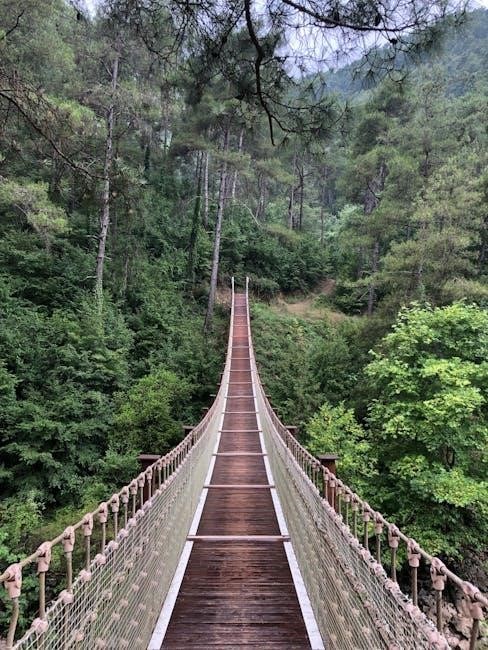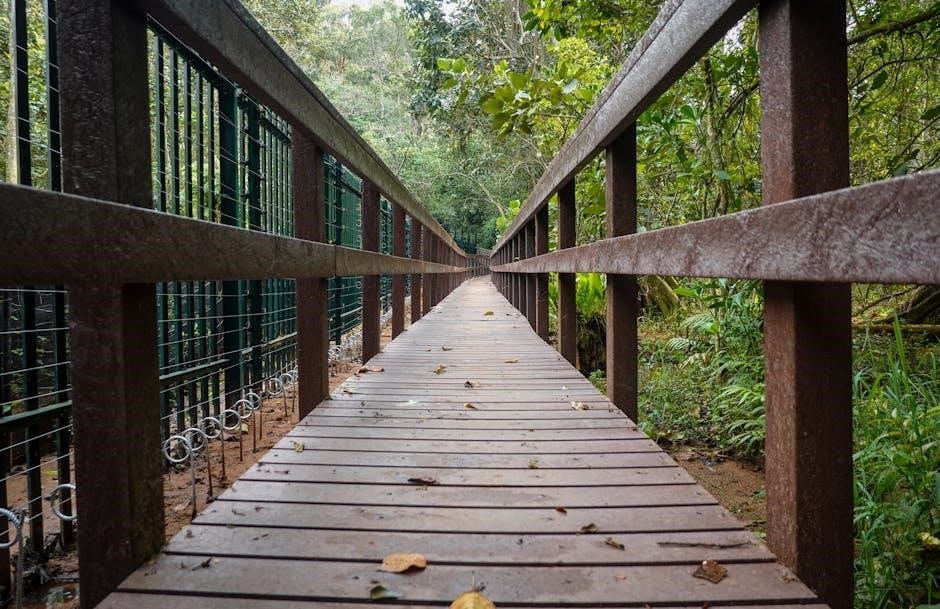The Long Trail, established in 1910, is the oldest long-distance hiking trail in the United States, spanning 272 miles across Vermont’s Green Mountains.
It offers a diverse terrain, from rugged peaks to serene forests, providing hikers with a unique outdoor experience and breathtaking views.
The trail is complemented by detailed maps, including a georeferenced PDF version, which can be used with GPS apps like Avenza Maps for easy navigation.
Whether you’re a seasoned hiker or a nature enthusiast, the Long Trail promises an unforgettable adventure through Vermont’s picturesque landscapes.

1.1 History of the Long Trail
The Long Trail, established in 1910, is the oldest long-distance hiking trail in the United States, stretching 272 miles across Vermont’s Green Mountains.
Founded by the Green Mountain Club, it was initially envisioned as a rugged path for hikers to explore Vermont’s natural beauty.
Over the years, the trail has evolved, with sections being relocated and improved to accommodate hikers and protect the environment.
Today, it remains a iconic route, offering a mix of challenging terrain and scenic views, attracting hikers from around the world.

The trail’s history is deeply tied to conservation efforts, promoting the preservation of Vermont’s wilderness.
Its legacy continues to inspire outdoor enthusiasts, making it a cornerstone of American hiking culture.
1.2 Key Features of the Long Trail
The Long Trail is a 272-mile hiking path stretching across Vermont’s Green Mountains, offering diverse terrain, from rugged mountain peaks to serene forests and wetlands.
It features over 166 miles of side trails, providing access to scenic overlooks, waterfalls, and remote wilderness areas.
Elevation changes are significant, with climbs exceeding 4,000 feet, making it a challenging yet rewarding experience for hikers.
The trail is well-marked with blazes and signs, ensuring easy navigation, while maps and guides are available in PDF and digital formats for added convenience.
Shelters and campsites are strategically located along the route, offering hikers places to rest and replenish supplies.
The Long Trail is also known for its conservation efforts, protecting natural habitats and wildlife, making it a must-visit destination for outdoor enthusiasts.

How to Use the Long Trail Map PDF
The Long Trail Map PDF is a georeferenced file, allowing users to navigate the trail using GPS-enabled devices like smartphones or tablets.
Download the PDF and open it in apps like Avenza Maps or Gaia GPS to access interactive features, such as GPS coordinates and location tracking.
Use the map to identify trailheads, shelters, and points of interest, ensuring a well-planned and enjoyable hiking experience on the Long Trail.
2.1 Understanding the Map Legend
The Long Trail Map PDF includes a detailed legend that explains the symbols and colors used to represent various features along the trail.
Key elements include trail markers, shelters, water sources, road crossings, and scenic viewpoints, each denoted by specific icons or colors.
The legend also highlights terrain difficulty, with different shades indicating steep inclines, flat sections, or rugged paths.
Additionally, it identifies points of interest such as campsites, parking areas, and trailheads, making it easier to plan your route.
Understanding the legend ensures you can interpret the map accurately, helping you navigate the trail with confidence and make the most of your hiking experience.
2.2 Using GPS Coordinates
The Long Trail Map PDF is enhanced with GPS coordinates, allowing hikers to pinpoint their location and navigate seamlessly.
These coordinates are embedded within the map, enabling users to access precise positions through apps like Gaia GPS or Avenza Maps.
By clicking on the coordinates in the PDF, users are directed to the exact location on the map, ensuring accurate trail navigation.
This feature is particularly useful in remote areas with limited cell service, providing reliable guidance and enhancing safety.
GPS coordinates simplify route planning and help hikers track their progress, making the Long Trail more accessible for both experienced and novice adventurers.

Features of the Long Trail Map
The Long Trail Map PDF includes detailed terrain elevation, trail markers, and symbols, ensuring hikers can navigate the 272-mile route with precision and confidence.
Its georeferenced design allows integration with GPS apps, making it a vital tool for both planning and real-time navigation on the trail.
3.1 Terrain and Elevation Details
The Long Trail Map PDF provides detailed elevation profiles, showcasing the varied terrain hikers encounter, from gentle slopes to steep mountain climbs.
Elevation data is clearly marked, allowing hikers to anticipate challenging sections and plan their routes accordingly, ensuring a safer and more enjoyable experience.
The map highlights key peaks and valleys, offering a comprehensive overview of Vermont’s Green Mountains, making it an indispensable resource for both novice and experienced hikers.
With accurate contour lines and elevation markers, the map helps users understand the landscape, aiding in better navigation and decision-making along the 272-mile trail.
3.2 Trail Markers and Symbols
The Long Trail Map PDF includes detailed trail markers and symbols, essential for navigation along the 272-mile path. These markers indicate key features such as trailheads, shelters, water sources, and scenic viewpoints, helping hikers stay oriented. Symbols are clearly defined in the map legend, ensuring users can quickly identify important landmarks and potential hazards. Blazes and signs along the trail correspond to the map’s markings, providing real-time guidance. This system ensures that even in remote areas, hikers can follow the route confidently. The map’s visual cues are designed to enhance the hiking experience, making it easier to explore Vermont’s Green Mountains safely and efficiently. These markers are a crucial part of the trail’s infrastructure, supporting both novice and experienced hikers.

Available Formats of the Map
The Long Trail map is available in PDF and digital formats, offering downloadable and printable versions, with GPS compatibility through apps like Avenza Maps.
4.1 PDF Format Benefits
The PDF format of the Long Trail map offers numerous advantages for hikers and outdoor enthusiasts. It is georeferenced, allowing users to track their location using GPS apps like Avenza Maps, even without internet access. The PDF can be easily downloaded and printed, providing a reliable physical copy for trail use. Its digital version is accessible on both desktop and mobile devices, ensuring versatility for different needs. The format preserves high-quality visuals, making it easy to read trail markers, symbols, and elevation details. Additionally, the PDF is compatible with popular navigation apps, enabling hikers to plot their route and mark points of interest. This feature-rich format enhances the hiking experience by providing precise location tracking and seamless access to trail information.
4.2 Digital Versions and Apps
Digital versions of the Long Trail map are available through apps like Avenza Maps, offering enhanced navigation tools such as GPS tracking and offline access. These apps allow hikers to download the georeferenced PDF map, enabling precise location tracking without internet connectivity. Users can mark waypoints, record trails, and access detailed elevation profiles, improving their overall hiking experience. The Avenza Maps app, in particular, is highlighted as a reliable platform for accessing the Long Trail map, ensuring that hikers can navigate confidently. Digital versions provide convenience and flexibility, making them indispensable for both casual and experienced hikers exploring Vermont’s iconic trail.

Navigation Techniques
Mastering navigation with the Long Trail map PDF involves using GPS coordinates and georeferenced files in apps like Gaia GPS for precise location tracking and route planning.
5.1 Essential Navigation Skills
Essential navigation skills for the Long Trail include understanding GPS coordinates, reading contour lines, and using landmarks to stay on track.
Hikers should practice orienting the map with the terrain and using a compass to determine direction, especially in areas with limited visibility;
Familiarity with georeferenced PDFs and GPS apps like Avenza Maps enhances navigation by allowing hikers to pinpoint their location and plan routes effectively.
Combining traditional map-reading techniques with digital tools ensures a safer and more enjoyable hiking experience on the Long Trail.
5.2 Recommended Tools
For navigating the Long Trail, essential tools include a georeferenced PDF map, a GPS-enabled smartphone with apps like Gaia GPS or Avenza Maps, and a compass for traditional navigation.
A detailed guidebook, such as the Green Mountain Club’s Long Trail Guide, provides trail descriptions and waypoints to assist hikers.
A waterproof physical map is a reliable backup, while trekking poles can aid stability on uneven terrain.
Carrying a portable power source ensures your devices remain functional throughout the hike.
These tools, combined with basic navigation skills, enhance safety and confidence on the trail.

Planning Your Hike
Plan your hike using the Long Trail map PDF to create an itinerary, check terrain, and estimate hiking time. Ensure weather conditions and permits are verified beforehand.
6.1 Creating an Itinerary
Creating an itinerary for your Long Trail hike is essential for a well-organized adventure. Use the Long Trail map PDF to break the 272-mile journey into manageable sections, considering your physical endurance and time constraints. Plan rest days and overnight stays at designated campsites or shelters. Highlight key landmarks, water sources, and trailheads on the map to ensure smooth navigation. The georeferenced PDF allows you to track your progress and adjust your schedule as needed. Marking waypoints for food resupply points and emergency exits is also crucial. By combining the map’s terrain details with your hiking pace, you can create a realistic and enjoyable itinerary for your journey through Vermont’s stunning Green Mountains.
6.2 Packing Essentials Checklist
When preparing for your Long Trail adventure, ensure you pack essentials to stay safe and comfortable. Start with a sturdy backpack and navigation tools like the Long Trail map PDF and a compass. Include a tent, sleeping bag, and sleeping pad for shelter. Bring durable hiking boots, extra socks, and layers of breathable clothing for varying weather conditions; Don’t forget a water filter or purification tablets, a hydration bladder, and high-energy snacks. A first aid kit, headlamp, and personal toiletries are must-haves. Add a portable stove and lightweight cookware for meal preparation. Consider trekking poles for added stability and a camera to capture scenic views. Finally, pack a small repair kit and emergency shelter. Always check the weather forecast and adjust your list accordingly to ensure a well-prepared journey.

Downloading and Installing the Map
Download the Long Trail map PDF from trusted sources like the Green Mountain Club or Avenza Maps. Install the Avenza Maps app for GPS-enabled navigation on your device.
7.1 Reliable Sources for Download
To ensure authenticity and accuracy, download the Long Trail map PDF from trusted sources such as the Green Mountain Club or the Avenza Maps platform.
These sources provide up-to-date, georeferenced maps that are compatible with GPS apps, enhancing your navigation experience on the trail.
Additionally, the Green Mountain Club’s official website offers a downloadable PDF version of the Long Trail Guide, which includes detailed topographic maps.
Always verify the source to avoid outdated or incorrect maps, ensuring a safe and enjoyable hiking experience.
By using reliable sources, you can trust the information provided, making your journey along the Long Trail more efficient and stress-free.
7.2 Installation on Devices
Installing the Long Trail map PDF on your device is straightforward. Download the georeferenced PDF from trusted sources like the Green Mountain Club or Avenza Maps.
For mobile devices, use apps like Avenza Maps, which allow you to import the PDF and access GPS features. Ensure your device has sufficient storage and GPS capabilities.
Once downloaded, open the PDF in a compatible app, and it will be ready for use. You can also transfer the map to other devices for shared use during your hike.
Ensure your device is fully charged and consider bringing a backup power source, as GPS and map apps can drain battery life quickly.
By installing the map on your device, you’ll have constant access to trail details, even without internet connectivity, making navigation seamless and stress-free.

Best Practices for Trail Usage
Respect nature by staying on designated trails and carrying out all trash. Plan your hike using the Long Trail map PDF and stay prepared with essentials.
8.1 Environmental Etiquette
Practicing environmental etiquette is crucial when using the Long Trail. Always stay on designated trails to avoid eroding sensitive habitats and respect wildlife by maintaining a safe distance. Carry out all trash, including food waste, to keep the trail clean and preserve natural beauty. Avoid disturbing plants and animals, as the Long Trail passes through protected areas. Use biodegradable soap and wash away from water sources to minimize ecological impact. Campfires should be small, contained, and extinguished completely before leaving. Be mindful of noise levels to not disrupt the serene environment. Refer to the Long Trail map PDF for eco-friendly guidelines and ensure your actions leave no trace for future hikers. By adhering to these principles, you help protect Vermont’s pristine landscapes.
8.2 Safety Precautions
When exploring the Long Trail, prioritize safety to ensure a secure and enjoyable experience. Always carry a first aid kit, extra water, and snacks, as remote sections may lack amenities.
Inform someone about your itinerary, including your start and end points, to ensure help can reach you if needed.
Check weather forecasts beforehand and avoid hiking during severe conditions. Familiarize yourself with the trail map PDF and use GPS coordinates to navigate accurately.
Stay on marked trails to minimize risks of getting lost or injured. Be cautious of uneven terrain and wildlife encounters.
Keep your phone charged, though cell service may be unreliable in remote areas.
Pack a headlamp or flashlight for unexpected delays and ensure your gear is suitable for varying conditions. By adhering to these precautions, you can safely enjoy the Long Trail’s breathtaking beauty.




Leave a Reply
You must be logged in to post a comment.